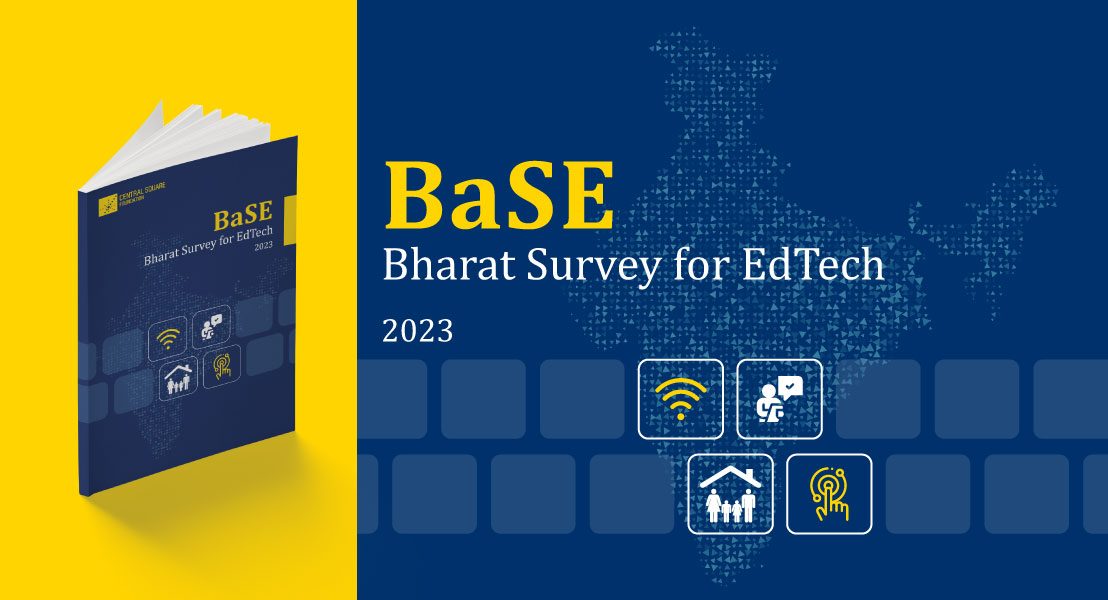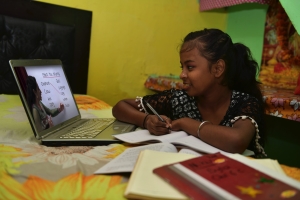The education technology (EdTech) industry has experienced remarkable growth in the last few years, emerging as one of the most rapidly expanding sectors globally. This growth can be attributed to favorable conditions, including an increase in internet users by approximately 530 million over the past 6 years, as well as a positive projection for smartphone penetration expected to reach 1 billion users by 2026. The online education market in India is expected to grow by US$ 2.28 billion during 2021-2025, growing at a CAGR of almost 20%.
Despite the increase in accessibility and distribution of EdTech solutions in India, a majority of these offerings primarily cater to and have been adopted by households belonging to middle and high-income brackets, perpetuating existing educational inequalities. There is an urgent need to democratize access and adoption of EdTech solutions to be able to tackle these inequalities.
At Central Square Foundation (CSF), we firmly believe that comprehensive, ground-up data can help inform and shape the EdTech ecosystem and democratize EdTech solutions in India. With this goal in mind, CSF commissioned and launched the Bharat Survey for EdTech (BaSE) in April 2023. The objective of this survey was to bridge the information gap and gain a deeper understanding of the needs, barriers, aspirations, and behaviors of low-income families towards EdTech adoption and usage.
The need for a comprehensive EdTech survey spotlighting low-income India
Existing research and literature discussing the state of EdTech in India tend to focus on gathering stakeholder-specific information, such as the viewpoints of investors or EdTech product companies. These surveys predominantly analyze the viability and profitability of EdTech solutions within specific market segments, often neglecting the perspectives and needs of users from low-income backgrounds.
The absence of comprehensive ground-up data and reliable insights on end users poses a significant challenge in developing custom EdTech solutions. This hinders policymakers, social innovators, educators, and other key decision makers from creating customized and user-centric educational technology that can truly address the unique requirements faced by different learners, especially from low-income segments.
The Bharat Survey for EdTech or BaSE is a first-of-its-kind household survey that represents the perspective of the end users in low-income contexts. By including voices of these users, the survey provides a valuable opportunity to influence and shape the future of EdTech in India. It offers a meaningful platform to engage in discussions and decision making that can have a lasting impact on the development and implementation of EdTech solutions tailored to the needs of underserved populations in the country.
BaSE was conducted between November 2022 and January 2023, with parents and guardians of children attending either government schools or affordable private schools. Spanning six geographically diverse states in India, the survey reached 6,030 households and 9,867 children. BaSE examines trends related to three main pillars: access to technology, user sentiment around EdTech adoption, and EdTech usage. These were carefully selected to ensure that the survey’s findings encompass a broad range of factors that influence an individual’s engagement with EdTech.

What can EdTech ecosystem stakeholders gain from BaSE?
BaSE yielded intriguing and valuable insights into the various aspects of the EdTech landscape, including technology access, user perceptions, and utilization of EdTech tools.
Some of the key findings include:
- Increasing smartphone penetration and enabling infrastructure
85% of households reported having access to smartphones, with the availability of electricity and the internet being nearly universal. Within the surveyed households, it was found that 72% of children had access to smartphones in some capacity. This access could be in the form of either sharing the smartphone with household members or having their own personal smartphone. This data indicates the prevalence of smartphone usage among children in these households, highlighting the potential for leveraging this technology for educational purposes.
- Children using technology were more likely to use it for self-directed learning
Of the number of children who used smartphones, 51% continued to use them for learning purposes during the survey period. Further, of all the children surveyed across households, 50%engaged in self-learning activities. This indicates a growing preference for independent learning among children using smartphones for educational purposes. Existing literature confirms that children are likely to use applications for learning on their own, without the need for any reminders or intervention. Further, BaSE highlights that most of the learning was done through online platforms such as YouTube (89%), WhatsApp (62%), and Google (52%), implying the tendency of children to take advantage of accessible resources at their disposal. Leveraging such ubiquitous resources to build contextual and user-centric solutions is instrumental in enhancing EdTech adoption.
- Parents’ attitudes towards EdTech influence children’s usage of EdTech
A majority of parents (almost 86%) exhibited awareness of technology’s potential for enhancing learning. Research suggests that parents are increasingly aware and willing to invest in technological tools for their children. Despite their concerns regarding the negative impact of technology on children’s health and their inability to afford certain applications, they do not want their children to miss out on opportunities by limiting their access to and usage of technology. The survey also highlighted a strong relationship between parents’ familiarity with smartphones and digital tools and their children’s engagement with EdTech. Specifically, when parents were adept at using at least one of the three tools—Facebook, YouTube, and Google—over 60% of the children were active users of educational technology. This underscores the influence of parental use of technology on children’s adoption of EdTech.
We anticipate that an increasing number of stakeholders and decision makers in the EdTech ecosystem will leverage the findings from BaSE to participate in evidence-based discussions and facilitate the creation of more impactful and tailored EdTech solutions, particularly for low-income populations. Additionally, we hope additional surveys that prioritize understanding the requirements and challenges faced by low-income EdTech users are conducted, as it plays a crucial role in bridging the information gap and promoting the development of effective educational technology.



